Yeovil people
Edwin Robert Bartlett
Founder of the Yeovil construction firm
 Edwin Robert
Bartlett was
born in 1832 at
Hardington
Mandeville and
was baptised at
St Mary's
church,
Hardington, on
Christmas Day
1832. He was one
of the eight
children of
carpenter and
builder
(employing seven
men) Robert
Bartlett
(1803-1885) and
Ann née Guppy
(1798-1871).
Edwin Robert
Bartlett was
born in 1832 at
Hardington
Mandeville and
was baptised at
St Mary's
church,
Hardington, on
Christmas Day
1832. He was one
of the eight
children of
carpenter and
builder
(employing seven
men) Robert
Bartlett
(1803-1885) and
Ann née Guppy
(1798-1871).
Robert and Ann's children were Walter William (1829-1909), Duncan (b1830), Sarah Elizabeth (1832-1901), Edwin, Susan Maria (1834-1835), Thomas Francis (1836-1906), Samuel George (1839-1909) and Herbert Henry, later Sir Herbert Henry Bartlett, 1st Baronet of Hardington Mandeville (1842-1921).
After learning the family trade as a carpenter and builder, Edwin travelled to London for work during the 1850s. In October 1863, at Marylebone, Middlesex, 30-year-old Edwin married 21-year-old Charlotte Cragg (1842-1900), the daughter of stonemason Thomas Cragg (1807-1852) and Ann née Hooten (1805-1886) from Caythorpe, Lincolnshire.
Edwin and Charlotte were to have seven children; Helen Annie (b1867, Paddington, London) and Francis Robert, known as "Frankie" (b1869, West Coker). All the following children were born in Yeovil; Bessie Ann (1870-1916), Elizabeth Charlotte, known as Lottie (b1872), Gertrude Sarah (1875-1935), Winifred Bertha (b1879) and Donald Edwin (b1880).
In 1870, 38-year-old Edwin set up his own building business in Kingston. The 1871 census recorded Edwin and Charlotte, together with Helen, Francis and Bessie living in Kingston. Edwin gave his occupation as a builder.
Edwin's construction business was very successful and within ten years he acquired the large building company of the recently-deceased Charles Harwood (1820-1879) who, in 1871, was recorded as employing 32 men and 10 boys.
By the time of the 1881 census, Edwin had moved his family to 76 South Street and was listed there with Charlotte and all seven children, a visitor and a domestic servant. He gave his occupation as a builder employing 16 men and 7 boys.
In 1882, Edwin made another significant expansion, buying from Harwood’s son, Henry, their brickworks at Mudford. This was a common practice at the time and several Yeovil builders owned their own brickworks to ensure a ready supply of bricks for their building projects. Initially, Henry Harwood had tried to run it himself, employing fourteen men in 1881, but since his main occupation was as a chemist, he did not have the necessary skills.
Running the Mudford brickworks profitably proved difficult for Edwin, even though he advertised in local newspapers. He even resorted to offering discounted prices, but nevertheless production often outpaced demand. At one point he had 250,000 drainpipes, 30,000 tiles and 50,000 bricks in stock that he tried to sell by auction. In 1892, Edwin was forced to close the business and sell off the remaining stock and equipment. Even so, in his advertisement in the 1895 edition of Whitby's Yeovil Almanack Advertiser of 1895 (see Gallery) he advertised himself as "Builder, Brickmaker & Undertaker". He was listed as a builder in Kelly's Directories, from 1889 to 1902 inclusive.
Nevertheless, Edwin’s construction business remained strong and he continued to seize business opportunities. For example, when the builder, John Rawlins, died in 1886, Edwin moved into Rawlins’s former home at 69 Hendford (next door to Hendford House, today's Manor Hotel), and this became the base of the firm’s operations until 1934. He also ran a separate undertaker's business.
In September 1892, the stock and farm implements of Aldon Farm were auctioned, and the timber of the farm (34 Beech, 9 Oak, 4 Elm, 6 Chestnut, 4 Fir, 1 Walnut and 1 Lime) was sold off in October 1892. It would appear that the timber was owned by "Mr Bartlett, Builder of Yeovil". Edwin was also active in buying property generally. In 1894, he bought 30, 31, 32 and 33 Vicarage Street at auction for £425 and, in 1895, he bought 39 and 40 Wellington Street at auction for £245. He also owned four houses on the east side of Beer Street and a building site in Sherborne Road.
Even when he was in his mid-sixties, he was still winning major contracts. In 1896 he won the contract to pull down and rebuild St John’s Schoolrooms, for which his tender was £2,164 3s 4d. In 1898, he built the Capital & Counties Bank on the corner of Princes Street and High Street - at which time the company was called Bartlett & Son.
Edwin was a Nonconformist and, as well as being a trustee of the Tabernacle chapel, he was also associated with the Congregational chapel. The Rev S T Allen, the town’s Congregational minister, officiated at the funeral of Edwin’s wife Charlotte, in 1895, and Allen’s son, Edgar, married Edwin’s daughter, Lottie, in 1897.
In August 1887, Edwin and his men went on a day trip to Weymouth, travelling in a horse-drawn charabanc hired from the Three Choughs, and enjoyed a long day of lavish meals and plenty of sightseeing. In 1895, he exhibited at Crewkerne Horse Show, and in 1894 and 1895 his firm erected the grandstand at Yeovil Agricultural Show.
Edwin died at his home at 69 Hendford on 18 June 1907 aged 76, leaving an estate valued at £6,204 (around £800,000 at today’s value).
Following Edwin's death, his eldest son Frances Robert (known as 'Frankie') took over the business, later known as FR Bartlett Ltd. In 1912-13 the company built the Palace of Varieties, Yeovil's first purpose-built cinema, on the corner of Stars Lane.
The company grew and became part of the Bartlett Construction Group Ltd. In 1969, the company bought Abbey Farm and several surrounding fields and began improvements to the property that would become the company's headquarters.
In the 1980s, joint developers, Standard Life Assurance and Yeovil-based Bartlett Developments built the Quedam shopping mall.
Later, as part of the Abbey Manor Group, it was acquired by the Hunting Gate Group. In 2000, FR Bartlett Ltd was acquired by the Exeter-based EBL Group. In the 15 months to 31 December 1999, the firm had made a profit of £88,000 on a turnover of £15 million, at which time Bartlett reported net assets of £469,000, including cash of £752,000. EBC paid a nominal £1 for Bartlett after it paid a special dividend of £350,000 to its parent company, Hunting Gate Group.
Many thanks to Desmond Danes for much of the above.
For the Bartlett family tree - click here.
gallery

Edwin Robert
Bartlett
1832 - 1907

The entry of Edwin's baptism of 25 December 1832 from the parish register St Mary's church, Hardington Mandeville.
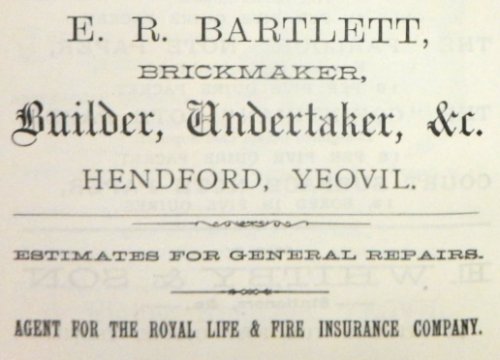
Edwin's advertisement in the 1895 edition of Whitby's Yeovil Almanack Advertiser.

The notice of Edwin's death in the 21 June 1907 edition of the Western Chronicle.

Bartlett's workers in a colourised photograph of 1914.

A view of the roundabout at the junction of Princes Street off to the left, Kingston at centre right and Reckleford at lower right. The single storey white building is FR Bartlett Ltd's 'Kingston Works'. A colourised photograph of 1973.
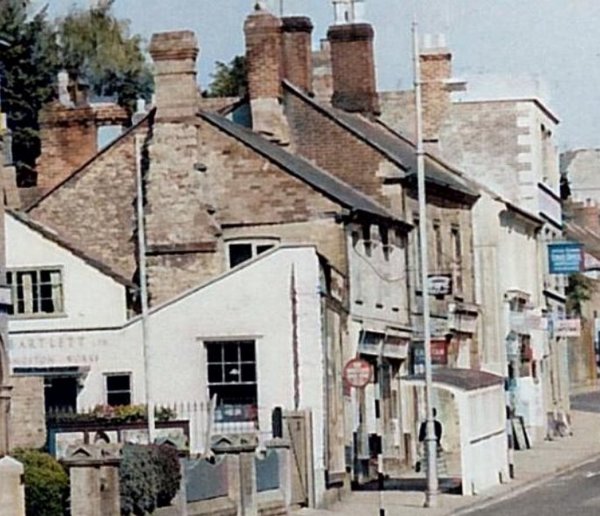
A colourised photograph of the late 1960s of Bartlett's Kingston premises.
Some Yeovil buildings built by Edwin Bartlett
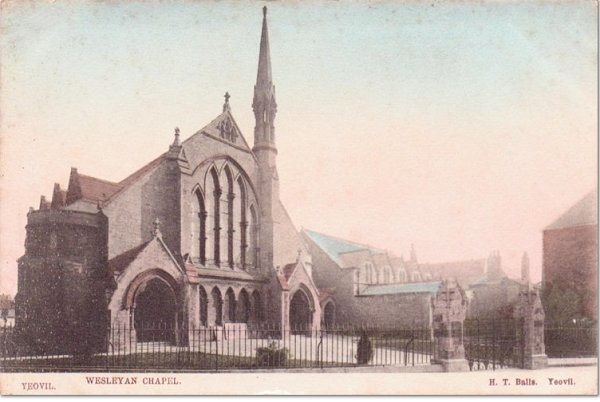
From my
collection.
This
image
features in my
book 'Yeovil
- The Postcard
Collection'.
A hand-coloured version of a postcard of the Wesleyan chapel, post-marked 1906.
In 1869-1870 the new Wesleyan Methodist church was built in Vicarage Street and opened on 30 March 1870. The Southern Times, in its edition of 9 April 1870, reported "The architect was Mr Alexander Lander of Barnstaple; and the contractors by whom the work has been very satisfactorily and creditably carried out are Messrs Bartlett & Son, of Coker, and Mr Charles Harwood, of Yeovil. The building, which cost £3,289 [around £450,000 at today's value] including purchase of land, is in the Early English Gothic style, and built entirely of the local Ham-hill stone".
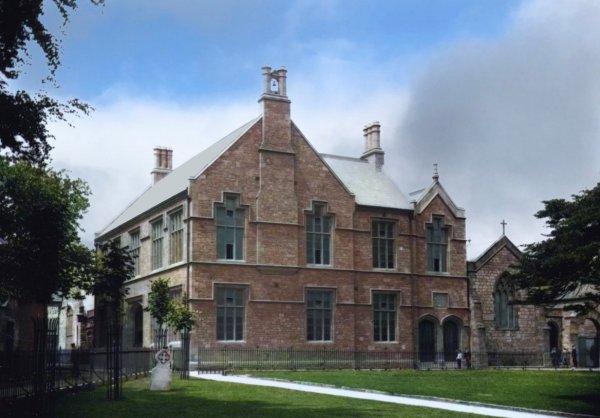
From the Stiby
Collection
(colourised),
Courtesy of South Somerset Heritage Collection
The newly-rebuilt (by Edwin Bartlett) St John's schoolrooms photographed around 1897 by Henry Stiby. Note the fence around the churchyard, originally designed to keep dogs out of the church.

The new Capital & Counties Bank building, which opened in the summer of 1897, was designed by Yeovil architect J Nicholson Johnston, A.R.I.B.A. and constructed by Bartlett & Son of Yeovil. A colourised photograph of 1906.
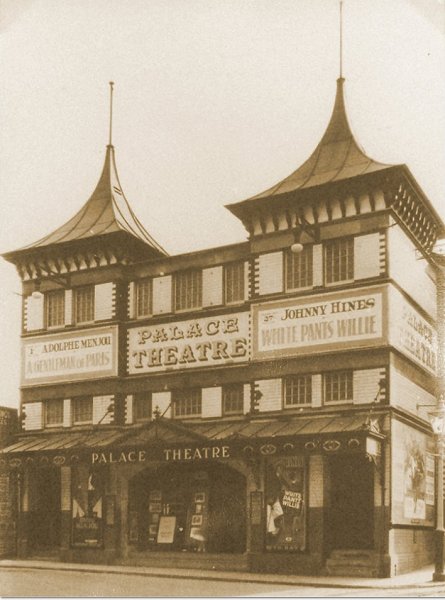
The Palace Theatre on the corner of Stars Lane, also known as the Palace of varieties, built by FR Bartlett in 1912-13. Photographed in 1927.

More recently, Bartlett's built the new library building in 1986 on the southeast corner of King George Street. Photographed in 2016.